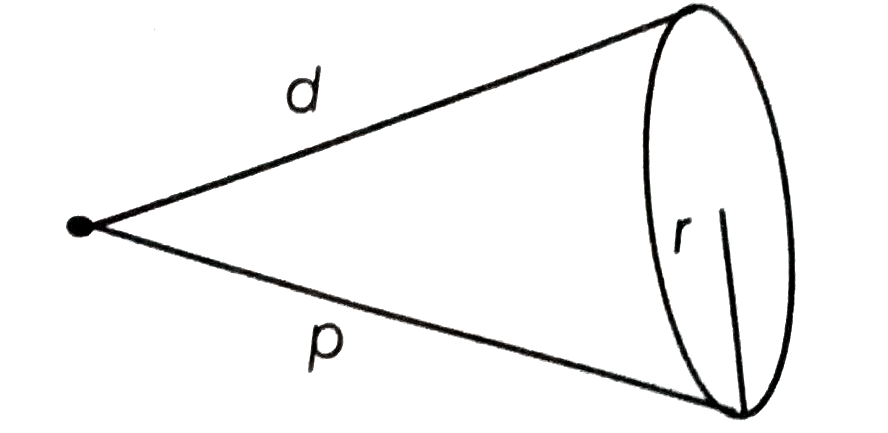Consider a 20W bulb emitting light of wavelength 5000Å and shinning on a metal surface kept at a distance 2m. Assume that the metal surface has work function of 2eV and that each atom on the metal surface can be treated as a circular disk of radius 1.5Å.
(i) Estimate no. of photons emitted by the bulb per second. [Assume no other losses] (ii) Will there be photoelectric emission? (iii) How much time would be required by the atomic disk to receive energy equal to work function 2eV? (iv) How many photons would atomic disk receive within time duration calculated in (iii) above? (v) Can you explain how photoelectric effect was observed instantaneously? [Hint : Time calculated in part (iii) is from classical consideration and you may further take the target of surface area say 1cm2 and estimate what would happen?]
Given, P=200W,λ=5000Å=5000×10−10m
d=2m,ϕ0=2eV,r=1.5A=1.5×10−10m
(i) Number of photon emitted by bulb per second is n' =phc/λ=pλhc
=20×(5000×10−10)(6.62×10−34)×(3×108)
⇒ =5×1019s−1
(ii) Energy of the incident photon
hcλ=(6.62×10−34)(3×108)5000×10−10×1.6×10−19
=2.48 eV
As this energy is greater than e eV (i.e., work function of metal surface), hence photolectric emission takes place.

(ii) Let Δt be the time spent in getting the energy ϕ= (work functiojn of metal). Consider the figure,
P4πd2×πr2Δt=ϕ0
⇒ Δt=4ϕ0d2Pr2
=4×(2×1.6×10−19)×2220×(1.5×10−10)2≈28.4s
(iv) Number of photons receivbed by atomic disc in time Δt is
N=n'×πr24πd2×Δt
⇒ =n'r2Δt4d2
=(5×1019)×(1.5×1010)2×28.44×(2)2≈2
(v) As time of emiccion of electrons is 11.04 s.
Hence, the photoelectric emission is not instantaneous in this problem.
In photoelectric emission, there is an collision between incident photon and free electron of the metal surface, which lasts for ever very short interval of time (≈10−9S), hence we say photoelectric emission is instantaneous.
Related Playlists
- BOOK - NCERT EXEMPLAR ENGLISHCHAPTER - DUAL NATURE OF RADIATION AND MATTEREXERCISE - SHORT ANSWER TYPE QUESTIONS6videos
DUAL NATURE OF RADIATION AND MATTER
- BOOK - NCERT EXEMPLAR ENGLISHCHAPTER - CURRENT ELECTRICITYEXERCISE - Very Short Answer Type Question.20videos
CURRENT ELECTRICITY
- BOOK - NCERT EXEMPLAR ENGLISHCHAPTER - ELECTRIC CHARGES AND FIELDEXERCISE - Long Answer Type Question6videos
ELECTRIC CHARGES AND FIELD
Similar Questions
Light of wavelength 4000 Å is incident on a metal surface. The maximum kinetic energy of emitted photoelectron is 2 eV. What is the work function of the metal surface ?
View SolutionLight of wavelenght 5000Å fall on a metal surface of work function 1.9eV Find
a. The energy of photonView SolutionLight of wavelength 4000A∘ is incident on a metal surface. The maximum kinetic energy of emitted photoelectron is 2 eV. What is the work function of the metal surface?
View SolutionLight of wavelength 2000 Å falls on a metallic surface whose work function is 4.21 eV. Calculate the stopping potential
View SolutionLight of wavelength 2000 Å falls on a metallic surface whose work function is 4.21 eV. Calculate the stopping potential
View SolutionLight of wavelength 3000Å is incident on a metal surface whose work function is 1 eV. The maximum velocity of emitted photoelectron will be
View SolutionLight of wavelength 3000Å is incident on a metal surface whose work function is 1 eV. The maximum velocity of emitted photoelectron will be
View SolutionLight of wavelength 3000Å is incident on a metal surface whose work function is 1 eV. The maximum velocity of emitted photoelectron will be
View SolutionLight of wavelenght 5000Å fall on a metal surface of work function 1.9eV Find
a. The energy of photon
b. The kinetic energy of photoelectronsView SolutionTwo photons, each of energy 2.5 eV are simultaneously incident on the metal surface. If the work function of the metal is 4.5 eV, then from the surface of metal
View Solution

